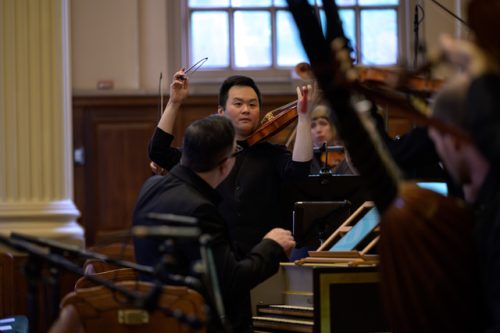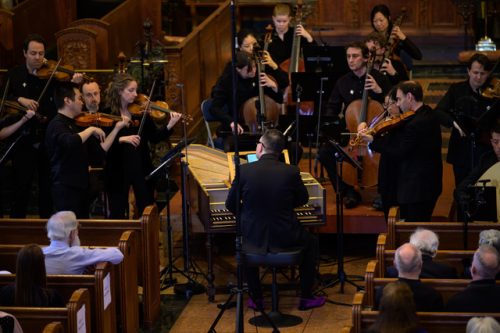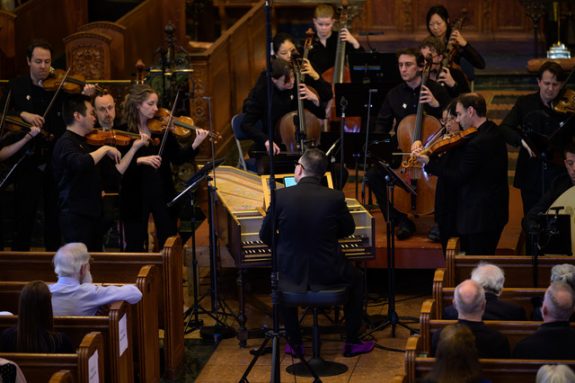 United States Various – ‘The 24 Violins Cross the Alps’: Sebastians. Brick Presbyterian Church, New York, 11.5.2024. (RP)
United States Various – ‘The 24 Violins Cross the Alps’: Sebastians. Brick Presbyterian Church, New York, 11.5.2024. (RP)

Lully – Selections from Atys, Le bourgeois gentilhomme, Les plaisirs de l’île enchantée
Corelli – Concerto grosso No.7 in D major, Op.6; Trio Sonata No.6 in E major, Op.4
Marais – Selections from Trios pour le coucher du roi
Muffat – from Armonico tributo: Sonata No.3 in A major, Sonata No.4 in E minor, Passacaglia Grave from Sonata No.5 in E minor
The Sebastians closed out their 2023/24 season with ‘The 24 Violins Cross the Alps’. The title was a bit of a misnomer because the orchestra consisted of not only a full cohort of string instruments but also a harpsichord, two theorbos and percussion. Nonetheless, it was true in spirit to the fabled ‘Les Vingt-quatre Violons du Roi’, an elite group of 24 musicians established by Louis XIII in 1626. The threshold requirements were that a player had to be Roman Catholic and have a sterling reputation. For those fortunate few, there were perks, including tax exempt status and the right to carry a rapier. Budget issues eventually necessitated that the orchestra be disbanded and merged with the musicians of the Chapelle Royale during the reign of Louis XV in 1761.
Jean-Baptiste Lully’s instantly recognizable music with its distinctive rhythms was the backbone of the concert. It was complemented with works by Marin Marais and Georg Muffat, both of whom studied with him. Arcangelo Corelli’s music was heard too, although the link was more tangential. He did pass through Paris when he was 19, but apparently did not find favor with Lully.
Lully climbed high at the court of Louis XIV, which was all the more remarkable for a foreigner. He was born Giovanni Battista Lulli in Italy and did not become a French citizen until 1661. Known today as a composer, performer and master of the French Baroque, Lully was also an excellent dancer. His performance as the mufti in the ‘Marche Pour la Cérémonie des Turcs’ from Le Bourgeois gentilhomme, for which he composed the music to a play by Molière, was a personal favorite of Louis XIV.
Marais, who is known for his mastery of the bass viol, was also a court musician at Versailles, a position he held from 1679 until 1725. As a composer, he is best known for his works for the bass viol, but he also contributed to Trios pour le coucher du rois, although most of the pieces in the collection were by Lully.
Muffat’s connection with Lully is relatively straightforward. He was definitely in Paris from 1663 until 1669, and he most likely studied with the French master. Muffat’s collection of six concerti grossi entitled Armonico tributo were inspired by those of Corelli, which he heard in the composer’s home in Rome. Stylistically, however, the works owe a debt to Lully.
Corelli, one of the great masters of the Italian Baroque, was especially important in the development of the sonata and concerto forms, and for establishing the primacy of the violin. The inclusion of his music in the program prompted the reference to crossing the Alps in the title.
The concert was performed in four parts with only brief pauses between works. Much longer breaks were devoted to tuning, a practice that Lully discouraged in his day. The music was beautiful, graceful and expertly performed and, due to the Sebastians’s attention to detail, stylistic differences between the music of Lully and Marais and that of Corelli and Muffat were readily discernible.
Lully’s music was drawn from the opera Atys, and from his ballets. As pronounced as the aforementioned rhythms, made even bolder by Rex Benincasa’s beating of the drum, shaking of the tambourine and tingling of the triangle, there were stylistic and structural elements that were equally distinctive.
Violinist Daniel Lee led the strings in the famous premier coup d’archet, the unified initial attack for which ‘Les Vingt-quatre Violons du Roi’ was famous. The tradition existed before Lully came on the scene, although he is credited with demanding uniform bowing. Each entrance was clear and delivered by the strings with a flourish of their bows. The energy with which they played was visceral.

Equally discernible in Lully’s music was the distinctive sound of music written in five equal parts, a style that prevailed in French instrumental music of the day. Geoffrey Grossman, the Sebastians’s artistic director and harpsichordist, noted in the program that it is all but impossible to replicate the sounds of the variety of viols played at the time. Even so, the Sebastians provided some sense of the sound and musical textures produced by that early group.
Muffat also employed five-part writing in his sonatas, although his textures were thicker, and there was a difference in articulation from the strings. The transparency and energy were there, but the attacks were less pronounced. The well-executed counterpoint in the Muffat sonatas was another aural signpost in the flow of music.
Most distinctive, however, was Corelli’s Trio Sonata in E major. Not only did it contain the flavors of the Italian Baroque, but it employed just three solo instruments and continuo. It was a showcase for Nicholas DiEugenio and Daniel Lee to display their virtuosity.
This was a joyous concert in all regards. The music was delightful, and the playing was superb. With such a fine ensemble, it is perhaps unfair to single out a single player, but violinist Daniel Lee is the spirit of the Sebastians, and his joy and enthusiasm are infectious. And, of course, the journey of the Sebastians began with his desire to play chamber music with friends at an high level. Just how high, he might not have imagined over 20 years ago.
Rick Perdian
